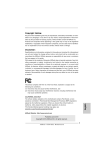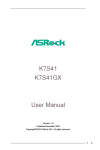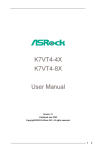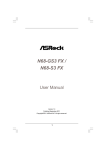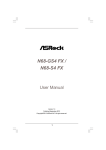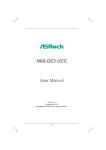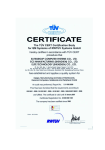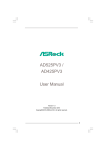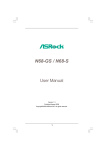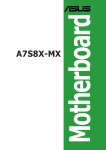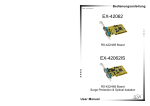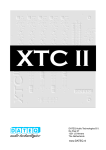Download Asrock K7S41GX2
Transcript
K7S41GX2 User Manual Version 1.0 Published June 2010 Copyright©2010 ASRock INC. All rights reserved. 1 Copyright Notice: No part of this manual may be reproduced, transcribed, transmitted, or translated in any language, in any form or by any means, except duplication of documentation by the purchaser for backup purpose, without written consent of ASRock Inc. Products and corporate names appearing in this manual may or may not be registered trademarks or copyrights of their respective companies, and are used only for identification or explanation and to the owners’ benefit, without intent to infringe. Disclaimer: Specifications and information contained in this manual are furnished for informational use only and subject to change without notice, and should not be constructed as a commitment by ASRock. ASRock assumes no responsibility for any errors or omissions that may appear in this manual. With respect to the contents of this manual, ASRock does not provide warranty of any kind, either expressed or implied, including but not limited to the implied warranties or conditions of merchantability or fitness for a particular purpose. In no event shall ASRock, its directors, officers, employees, or agents be liable for any indirect, special, incidental, or consequential damages (including damages for loss of profits, loss of business, loss of data, interruption of business and the like), even if ASRock has been advised of the possibility of such damages arising from any defect or error in the manual or product. This device complies with Part 15 of the FCC Rules. Operation is subject to the following two conditions: (1) this device may not cause harmful interference, and (2) this device must accept any interference received, including interference that may cause undesired operation. CALIFORNIA, USA ONLY The Lithium battery adopted on this motherboard contains Perchlorate, a toxic substance controlled in Perchlorate Best Management Practices (BMP) regulations passed by the California Legislature. When you discard the Lithium battery in California, USA, please follow the related regulations in advance. “Perchlorate Material-special handling may apply, see www.dtsc.ca.gov/hazardouswaste/perchlorate” ASRock Website: http://www.asrock.com 2 Contents 1 . Introduction ............................................................ 5 1.1 1.2 1.3 1.4 Package Contents ..................................................................... Specifications ........................................................................... Motherboard Layout ................................................................. I/O Panel .................................................................................... 5 6 10 11 2 . Installation .............................................................. 12 Pre-installation Precautions ............................................................... 2.1 CPU Installation ......................................................................... 2.2 Installation of CPU Fan and Heatsink ....................................... 2.3 Installation of Memory Modules (DIMM) .................................... 2.4 Expansion Slots (PCI, AMR and AGP Slots) ............................. 2.5 Jumpers Setup .......................................................................... 2.6 Onboard Headers and Connectors .......................................... 2.7 Driver Installation Guide ............................................................ 12 13 13 14 15 16 18 21 3 . BIOS SSETUP ETUP UTILITY ................................................... 22 3.1 3.2 3.3 3.4 3.5 3.6 3.7 3.8 Introduction ............................................................................... 3.1.1 BIOS Menu Bar ............................................................... 3.1.2 Navigation Keys ............................................................. Main Screen .............................................................................. OC Tweaker Screen ................................................................. Advanced Screen .................................................................... 3.4.1 CPU Configuration .......................................................... 3.4.2 Chipset Configuration ..................................................... 3.4.3 ACPI Configuration ......................................................... 3.4.4 Storage Configuration .................................................... 3.4.5 PCIPnP Configuration ...................................................... 3.4.6 Floppy Configuration ...................................................... 3.4.7 Super IO Configuration ................................................... 3.4.8 USB Configuration .......................................................... Hardware Health Event Monitoring Screen ............................. Boot Screen .............................................................................. 3.6.1 Boot Settings Configuration ........................................... Security Screen ........................................................................ Exit Screen ............................................................................... 22 22 23 23 24 26 27 28 29 30 32 33 33 35 36 36 37 38 39 3 4 . Software Support ................................................... 40 4.1 4.2 4 Install Operating System ........................................................... Support CD Information ............................................................. 4.2.1 Running Support CD ....................................................... 4.2.2 Drivers Menu .................................................................. 4.2.3 Utilities Menu ................................................................... 4.2.4 Contact Information ........................................................ 40 40 40 40 40 40 1. Introduction Thank you for purchasing ASRock K7S41GX2 motherboard, a reliable motherboard produced under ASRock’s consistently stringent quality control. It delivers excellent performance with robust design conforming to ASRock’s commitment to quality and endurance. In this manual, chapter 1 and 2 contain introduction of the motherboard and step-bystep guide to the hardware installation. Chapter 3 and 4 contain the configuration guide to BIOS setup and information of the Support CD. Because the motherboard specifications and the BIOS software might be updated, the content of this manual will be subject to change without notice. In case any modifications of this manual occur, the updated version will be available on ASRock website without further notice. You may find the latest VGA cards and CPU support lists on ASRock website as well. ASRock website http://www.asrock.com If you require technical support related to this motherboard, please visit our website for specific information about the model you are using. www.asrock.com/support/index.asp 1.1 Package Contents One ASRock K7S41GX2 Motherboard (Micro ATX Form Factor: 9.6-in x 7.8-in, 24.4 cm x 19.8 cm) One ASRock K7S41GX2 Quick Installation Guide One ASRock K7S41GX2 Support CD One 80-conductor Ultra ATA 66/100/133 IDE Ribbon Cable One Ribbon Cable for a 3.5-in Floppy Drive One I/O Panel Shield 5 1.2 Specifications Platform CPU Chipset Memory Expansion Slot Graphics Audio LAN Rear Panel I/O Connector 6 - Micro ATX Form Factor: 9.6-in x 7.8-in, 24.4 cm x 19.8 cm - Socket 462 for AMD Sempron / Athlon / Athlon XP / Duron Processors - FSB 333/266/200 MHz - Northbridge: SiS® 741GX - Southbridge: SiS® 963L - 2 x DDR DIMM slots - Support DDR 400/333/266 non-ECC, un-buffered memory - Max. capacity of system memory: 2GB - 1 x AGP 8X/4X slot (see CAUTION 1) - 1 x AMR slot - 2 x PCI slots - Integrated Mirage Graphics - DirectX 7 - Max. shared memory 128MB (see CAUTION 2) - Supports D-Sub with max. resolution up to 2048x1536 @ 75Hz - 5.1 CH AC’97 Audio (C-Media® CMI9739A Audio Codec) - Realtek LAN PHY RTL8201EL - Speed: 10/100 Ethernet - Supports Wake-On-LAN I/O Panel - 1 x PS/2 Mouse Port - 1 x PS/2 Keyboard Port - 1 x Parallel Port (ECP/EPP Support) - 1 x Serial Port: COM1 - 1 x VGA Port - 4 x Ready-to-Use USB 2.0 Ports - 1 x RJ-45 LAN Port with LED (ACT/LINK LED and SPEED LED) - Audio Jack: Line in / Front Speaker / Microphone - 2 x ATA133 IDE connectors (support 4 x IDE devices) - 1 x Floppy connector - 1 x IR header - CPU/Chassis FAN connector - 20 pin ATX power connector - CD in header - AUX in header - Front panel audio header BIOS Feature Support CD Unique Feature Hardware Monitor OS Certifications - 1 x USB 2.0 header (supports 2 USB 2.0 ports) (see CAUTION 3) - 2Mb AMI Legal BIOS - Supports “Plug and Play” - ACPI 1.1 Compliance Wake Up Events - SMBIOS 2.3.1 Support - Drivers, Utilities, AntiVirus Software (Trial Version) - Intelligent Energy Saver (see CAUTION 4) - Instant Boot - ASRock Instant Flash (see CAUTION 5) - Hybrid Booster: - CPU Frequency Stepless Control (see CAUTION 6) - ASRock U-COP (see CAUTION 7) - Boot Failure Guard (B.F.G.) - CPU Temperature Sensing - Chassis Temperature Sensing - CPU Fan Tachometer - Chassis Fan Tachometer - Voltage Monitoring: +12V, +5V, +3.3V, Vcore - Microsoft® Windows® 2000 / XP compliant - FCC, CE, WHQL - ErP/EuP Ready (ErP/EuP ready power supply is required) (see CAUTION 8) * For detailed product information, please visit our website: http://www.asrock.com WARNING Please realize that there is a certain risk involved with overclocking, including adjusting the setting in the BIOS, applying Untied Overclocking Technology, or using the thirdparty overclocking tools. Overclocking may affect your system stability, or even cause damage to the components and devices of your system. It should be done at your own risk and expense. We are not responsible for possible damage caused by overclocking. 7 CAUTION! 1. Do NOT use a 3.3V AGP card on the AGP slot of this motherboard! It may cause permanent damage! 2. The maximum shared memory size is defined by the chipset vendor and is subject to change. Please check SiS® website for the latest information. 3. Power Management for USB 2.0 works fine under Microsoft® Windows® XP SP1 or SP2 / 2000 SP4. 4. Featuring an advanced proprietary hardware and software design, Intelligent Energy Saver is a revolutionary technology that delivers 5. unparalleled power savings. ASRock Instant Flash is a BIOS flash utility embedded in Flash ROM. This convenient BIOS update tool allows you to update system BIOS without entering operating systems first like MS-DOS or Windows®. With this utility, you can press <F6> key during the POST or press <F2> key to BIOS setup menu to access ASRock Instant Flash. Just launch this tool and save the new BIOS file to your USB flash drive, floppy disk or hard drive, then you can update your BIOS only in a few clicks without preparing an additional floppy diskette or other complicated flash utility. Please be noted that the USB flash drive or hard drive must use FAT32/16/12 file 6. system. Although this motherboard offers stepless control, it is not recommended to perform over clocking. Frequencies other than the recommended CPU bus frequencies may cause the instability of the system or damage the CPU. The CPU host frequency of this motherboard is determined by the jumper-setting. You must set the FSB jumper according to your AMD CPU before you use the “Manual” option as the FSB setting in BIOS setup to perform over clocking. Please check page 24 for details. 7. While CPU overheat is detected, the system will automatically shutdown. Before you resume the system, please check if the CPU fan on the motherboard functions properly and unplug the power cord, then plug it back again. To improve heat dissipation, remember to spray thermal grease between the CPU and the heatsink when you install the PC system. 8 8. EuP, stands for Energy Using Product, was a provision regulated by European Union to define the power consumption for the completed system. According to EuP, the total AC power of the completed system shall be under 1.00W in off mode condition. To meet EuP standard, an EuP ready motherboard and an EuP ready power supply are required. According to Intel’s suggestion, the EuP ready power supply must meet the standard of 5v standby power efficiency is higher than 50% under 100 mA current consumption. For EuP ready power supply selection, we recommend you checking with the power supply manufacturer for more details. 9 1.3 Motherboard Layout 1 2 3 4 5 6 19.8cm (7.8-in) USB 2.0 Top: T: USB0 RJ-45 B: USB1 J1 LAN PHY SiS 741GX Chipset 1 27 1 1 Designed in Taipei Center: FRONT 24 FSB_SEL1 FSB_SEL0 Top: LINE IN Bottom: MIC IN 26 25 K7S41GX2 USB 2.0 T: USB2 B: USB3 28 IDE2 IDE1 1.5V_AGP1 9 AUDIO CODEC PCI 1 SiS 963L PCI 2 AUDIO1 1 Super I/O 10 2Mb BIOS USB_PWR1 CMOS Battery 10 CHA_FAN1 CLRCMOS1 1 FLOPPY1 JR1 JL1 IR1 AMR1 20 1 2 3 4 5 6 7 8 9 10 11 12 13 14 7 8 ErP/EuP Ready 23 22 21 24.4cm (9.6-in) CPU_FAN1 DDR2 (64 bit, 184-pin module) VGA1 PARALLEL PORT COM1 ATXPWR1 PS2_USB_PWR1 DDR1 (64 bit, 184-pin module) PS2 Mouse PS2 Keyboard 1 1 USB45 RoHS SPEAKER1 1 1 19 18 17 16 PS2_USB_PWR1 Jumper CPU Fan Connector (CPU_FAN1) CPU Socket North Bridge Controller 184-pin DDR DIMM Slots (DDR 1- 2) ATX Power Connector (ATXPWR1) Secondary IDE Connector (IDE2, Black) Primary IDE Connector (IDE1, Blue) AGP Slot (1.5V_AGP1) South Bridge Controller Clear CMOS (CLRCMOS1) Chassis Fan Connector (CHA_FAN1) System Panel Connector (PANEL1) Chassis Speaker Connector (SPEAKER 1) 15 16 17 18 19 20 21 22 23 24 25 26 27 28 15 11 12 PLED PWRBTN PANEL 1 1 HDLED RST 14 13 Floppy Connector (FLOPPY1) USB_PWR1 Jumper USB 2.0 Connector (USB45, Blue) Flash Memory Infrared Module Connector (IR1) AMR Slot (AMR1) JL1 Jumper JR1 Jumper Front Panel Audio Connector (AUDIO1) PCI Slots (PCI 1- 2) FSB Select Jumpers (FSB_SEL0/FSB_SEL1) Internal Audio Connector: CD1 (Black) Internal Audio Connector: AUX1 (White) J1 Jumpers 1.4 I/O Panel 2 1 3 4 5 6 11 1 2 3 4 5 6 10 9 8 PS/2 Mouse Port (Green) Parallel Port RJ-45 Port Line In (Light Blue) Line Out (Lime) Microphone (Pink) 7 8 9 10 11 7 USB 2.0 Ports (USB01) USB 2.0 Ports (USB23) VGA Port COM Port PS/2 Keyboard Port (Purple) LAN Port LED Indications Activity/Link LED Status Description Off No Activity Blinking Data Activity SPEED LED Status Description Green Green 10Mbps connection 100Mbps connection ACT/LINK SPEED LED LED LAN Port 11 Chapter 2 Installation K7S41GX2 is a Micro ATX form factor (9.6-in x 7.8-in, 24.4 cm x 19.8 cm) motherboard. Before you install the motherboard, please study the configuration of your chassis to ensure that the motherboard fits into it. Pre-installation Precautions Take note of the following precautions before you install motherboard components or change any motherboard settings. 1. Unplug the power cord from the wall socket before touching any component. 2. To avoid damaging the motherboard components due to static electricity, NEVER place your motherboard directly on the carpet or the like. Also remember to use a grounded wrist strap or touch a safety grounded object before you handle components. 3. Hold components by the edges and do not touch the ICs. 4. Whenever you uninstall any component, place it on a grounded antistatic pad or in the bag that comes with the component. Before you install or remove any component, ensure that the power is switched off or the power cord is detached from the power supply. Failure to do so may cause severe damage to the motherboard, peripherals, and/or components. 12 2.1 CPU Installation Step 1. Step 2. Unlock the socket by lifting the lever up to a 90 angle. Position the CPU directly above the socket such that its marked corner matches the base of the socket lever. Carefully insert the CPU into the socket until it fits in place. Step 3. o The CPU fits only in one correct orientation. DO NOT force the CPU into the socket to avoid bending of the pins. Step 4. When the CPU is in place, press it firmly on the socket while you push down the socket lever to secure the CPU. The lever clicks on the side tab to indicate that it is locked. CPU Marked Corner Lever 90° Up Socket Marked Corner STEP 1: Lift Up The Socket Lever 2.2 STEP 2/STEP 3: STEP 4: Match The CPU Marked Corner Push Down And Lock to The Socket Marked Corner The Socket Lever Installation of CPU Fan and Heatsink This motherboard adopts 462-pin CPU socket to support AMD Athlon XP / Duron CPU. It requires larger heatsink and cooling fan to dissipate heat. You also need to spray thermal grease between the CPU and the heatsink to improve heat dissipation. Make sure that the CPU and the heatsink are securely fastened and in good contact with each other. Then connect the CPU fan to the CPU_FAN connector (CPU_FAN1, see page 10, No. 2). For proper installation, please kindly refer to the instruction manuals of the CPU fan and the heatsink. 13 2.3 Installation of Memory Modules (DIMM) K7S41GX2 motherboard provides two 184-pin DDR (Double Data Rate) DIMM slots. Please make sure to disconnect power supply before adding or removing DIMMs or the system components. Step 1. Step 2. Unlock a DIMM slot by pressing the retaining clips outward. Align a DIMM on the slot such that the notch on the DIMM matches the break on the slot. notch break notch break The DIMM only fits in one correct orientation. It will cause permanent damage to the motherboard and the DIMM if you force the DIMM into the slot at incorrect orientation. Step 3. 14 Firmly insert the DIMM into the slot until the retaining clips at both ends fully snap back in place and the DIMM is properly seated. 2.4 Expansion Slots (PCI, AMR, and AGP Slots) There are 2 PCI slots, 1 AMR slot, and 1 AGP slot on K7S41GX2 motherboard. PCI slots: PCI slots are used to install expansion cards that have the 32-bit PCI interface. AMR slot: The AMR slot is used to insert an ASRock MR card (optional) with v.92 Modem functionality. AGP slot: The AGP slot is used to install a graphics card. The ASRock AGP slot has a special design of clasp that can securely fasten the inserted graphics card. Please do NOT use a 3.3V AGP card on the AGP slot of this motherboard! It may cause permanent damage! For the voltage information of your graphics card, please check with the graphics card vendors. Installing an expansion card Step 1. Step 2. Step 3. Step 4. Step 5. Step 6. Before installing the expansion card, please make sure that the power supply is switched off or the power cord is unplugged. Please read the documentation of the expansion card and make necessary hardware settings for the card before you start the installation. Remove the system unit cover (if your motherboard is already installed in a chassis). Remove the bracket facing the slot that you intend to use. Keep the screws for later use. Align the card connector with the slot and press firmly until the card is completely seated on the slot. Fasten the card to the chassis with screws. Replace the system cover. 15 2.5 Jumpers Setup The illustration shows how jumpers are setup. When the jumper cap is placed on pins, the jumper is “Short”. If no jumper cap is placed on pins, the jumper is “Open”. The illustration shows a 3-pin jumper whose pin1 and pin2 are “Short” when jumper cap is placed on these 2 pins. Jumper Setting FSB Select 1_2 FSB_SEL1 FSB_SEL1 Jumpers 2_3 (see p.10 No. 25) Description FSB_SEL1 FSB 200MHz 1_2 2_3 FSB_SEL0 FSB_SEL0 1_2 2_3 FSB 266MHz FSB_SEL0 FSB 333MHz Note: The setting of the CPU front side bus frequency of this motherboard is by means of the adjustment of jumper-setting. You must set the FSB jumper according to your AMD CPU before you use the “Manual” option as the FSB setting in BIOS setup to perform over clocking. Please follow the figures above to set the CPU front side bus frequency. PS2_USB_PWR1 Short pin2, pin3 to enable +5VSB (standby) for PS/2 +5V +5VSB or USB01/23 wake up events. Note: To select +5VSB, it requires 2 Amp and higher standby current provided by power supply. 1_2 2_3 (see p.10 No. 1) USB_PWR1 Short pin2, pin3 to enable +5VSB (standby) for +5V +5VSB USB4_5 wake up events. Note: To select +5VSB, it requires 2 Amp and higher standby current provided by power supply. (see p.10 No. 16) 16 1_2 2_3 JR1(see p.10 No. 22) JL1(see p.10 No. 21) JR1 JL1 Note: If the jumpers JL1 and JR1 are short (see the figure above), both front panel and rear panel audio connectors can work. Clear CMOS (CLRCMOS1, 2-pin jumper) 2-pin jumper (see p.10 No. 11) Note: CLRCMOS1 allows you to clear the data in CMOS. The data in CMOS includes system setup information such as system password, date, time, and system setup parameters. To clear and reset the system parameters to default setup, please turn off the computer and unplug the power cord from the power supply. After waiting for 15 seconds, use a jumper cap to short 2 pins on CLRCMOS1 for 5 seconds. 17 J1 Jumpers E (see p.10 No. 28) D C B A 1 Note: The set of J1 jumpers are only for advanced users to adjust the multiplier of CPU. Please follow the table below to adjust the multiplier of CPU. However, the system will work well without the adjustment of multiplier. You do not have to adjust the multiplier for normal usage. Multiplier A B C D E 5x 5.5x 1-2 2-3 1-2 1-2 2-3 2-3 1-2 1-2 1-2 1-2 6x 6.5x 1-2 2-3 2-3 2-3 2-3 2-3 1-2 1-2 1-2 1-2 7x 7.5x 1-2 2-3 1-2 1-2 1-2 1-2 2-3 2-3 1-2 1-2 8x 8.5x 1-2 2-3 2-3 2-3 1-2 1-2 2-3 2-3 1-2 1-2 9x 9.5x 1-2 2-3 1-2 1-2 2-3 2-3 2-3 2-3 1-2 1-2 10x 10.5x 1-2 2-3 2-3 2-3 2-3 2-3 2-3 2-3 1-2 1-2 11x 11.5x 1-2 2-3 1-2 1-2 1-2 1-2 1-2 1-2 1-2 1-2 12x 12.5x 1-2 2-3 2-3 2-3 1-2 1-2 1-2 1-2 1-2 1-2 13x 13.5x 1-2 2-3 1-2 1-2 2-3 2-3 1-2 1-2 2-3 2-3 14x 15x 1-2 1-2 2-3 1-2 2-3 1-2 1-2 2-3 2-3 2-3 16x 16.5x 1-2 2-3 2-3 2-3 1-2 1-2 2-3 2-3 2-3 2-3 17x 18x 1-2 2-3 1-2 1-2 2-3 2-3 2-3 2-3 2-3 2-3 19x 20x 2-3 2-3 1-2 2-3 1-2 1-2 1-2 1-2 2-3 2-3 21x 22x 2-3 2-3 2-3 1-2 2-3 1-2 1-2 2-3 2-3 2-3 23x 24x 1-2 2-3 2-3 2-3 2-3 2-3 2-3 2-3 2-3 2-3 For example, “Athlon XP 2000+” is an 1666MHz CPU: 12.5 (Multiplier) X 133MHz (External frequency) = 1666MHz FID jumpers setting: 1 The jumper caps are not provided by ASRock. Please understand that ASRock does not guarantee and support the adjustment of multiplier. These jumpers setting may not apply to all multiplier-locked or even some unlocked AMD CPU. Frequencies other than the recommended CPU bus frequencies may cause the instability of the system or damage the CPU. 18 2.6 Connectors Connectors are NOT jumpers. DO NOT place jumper caps over these connectors. Placing jumper caps over the connectors will cause permanent damage of the motherboard! Connector FDD Connector Figure Description (33-pin FLOPPY1) (see p.10 No. 15) FLOPPY1 Pin1 the red-striped side to Pin1 Note: Make sure the red-striped side of the cable is plugged into Pin1 side of the connector. Primary IDE Connector (Blue) Secondary IDE Connector (Black) (39-pin IDE1, see p.10 No. 8) (39-pin IDE2, see p.10 No. 7) PIN1 IDE1 PIN1 IDE2 connect the black end to the IDE devices connect the blue end to the motherboard 80-conductor, ATA 66/100/133 cable Note: If you use only one IDE device on this motherboard, please set the IDE device as “Master”. Please refer to the instruction of your IDE device vendor for the details. Besides, to optimize compatibility and performance, please connect your hard disk drive to the primary IDE connector (IDE1, blue) and CD-ROM to the secondary IDE connector (IDE2, black). USB 2.0 Connector USB_PWR P-5 P+5 GND DUMMY (9-pin USB45) (see p.10 No. 17) 1 GND P+4 P-4 USB_PWR Infrared Module Connector IRTX +5V DUMMY (5-pin IR1) (see p.10 No. 19) 1 There are 4 default USB 2.0 ports on the rear panel. If the rear USB ports are not sufficient, this USB 2.0 connector is available to support 2 additional USB 2.0 ports. This connector supports an optional wireless transmitting and receiving infrared module. GND IRRX 19 Internal Audio Connectors AUX1 (4-pin CD1, 4-pin AUX1) (CD1: see p.10 No. 26) (AUX1: see p.10 No. 27) CD1 Front Panel Audio Connector GND +5VA BACKOUT-R BACKOUT-L (9-pin AUDIO1) (see p.10 No. 23) 1 These connectors allow you to receive stereo audio input from sound sources such as a CDROM, DVD-ROM, TV tuner card, or MPEG card. This is an interface for front panel audio cable that allows convenient connection and control of audio devices. AUD-OUT-L DUMMY AUD-OUT-R MIC-POWER MIC System Panel Connector PLED+ PLEDPWRBTN# GND (9-pin PANEL1) (see p.10 No. 13) This connector accommodates several system front panel functions. 1 DUMMY RESET# GND HDLEDHDLED+ Chassis Speaker Connector (4-pin SPEAKER 1) (see p.10 No. 14) 1 SPEAKER DUMMY DUMMY +5V Chassis Fan Connector (3-pin CHA_FAN1) (see p.10 No. 12) CPU Fan Connector (3-pin CPU_FAN1) (see p.10 No. 2) ATX Power Connector (20-pin ATXPWR1) (see p.10 No. 6) 20 GND +12V CHA_FAN_SPEED Please connect the chassis speaker to this connector. Please connect a chassis fan cable to this connector and match the black wire to the ground pin. Please connect a CPU fan cable to this connector and match the black wire to the ground pin. Please connect an ATX power supply to this connector. 2.7 Driver Installation Guide To install the drivers to your system, please insert the support CD to your optical drive first. Then, the drivers compatible to your system can be auto-detected and listed on the support CD driver page. Please follow the order from up to bottom side to install those required drivers. Therefore, the drivers you install can work properly. 21 Chapter 3 BIOS SETUP UTILITY 3.1 Introduction This section explains how to use the BIOS SETUP UTILITY to configure your system. The SPI Memory on the motherboard stores the BIOS SETUP UTILITY. You may run the BIOS SETUP UTILITY when you start up the computer. Please press <F2> or <Del> during the Power-On-Self-Test (POST) to enter the BIOS SETUP UTILITY, otherwise, POST will continue with its test routines. If you wish to enter the BIOS SETUP UTILITY after POST, restart the system by pressing <Ctl> + <Alt> + <Delete>, or by pressing the reset button on the system chassis. You may also restart by turning the system off and then back on. Because the BIOS software is constantly being updated, the following BIOS setup screens and descriptions are for reference purpose only, and they may not exactly match what you see on your screen. 3.1.1 BIOS Menu Bar The top of the Main OC Tweaker Advanced H/W Monitor Boot screen has a menu bar with the following selections: To set up the system time/date information To set up overclocking features To set up the advanced BIOS features To display current hardware status To set up the default system device to locate and load the Operating System Security To set up the security features Exit To exit the current screen or the BIOS SETUP UTILITY Use < > key or < > key to choose among the selections on the menu bar, and then press <Enter> to get into the sub screen. 22 3.1.2 Navigation Keys Please check the following table for the function description of each navigation key. Navigation Key(s) / / + / <Enter> <F1> <F9> <F10> <ESC> 3.2 Function Description Moves cursor left or right to select Screens Moves cursor up or down to select items To change option for the selected items To bring up the selected screen To display the General Help Screen To load optimal default values for all the settings To save changes and exit the BIOS SETUP UTILITY To jump to the Exit Screen or exit the current screen Main Screen When you enter the BIOS SETUP UTILITY, the Main screen will appear and display the system overview. Main OC Tweaker BIOS SETUP UTILITY Advanced H/W Monitor Boot System Overview System Time System Date [17:00:09] [Mon 06/14/2010] BIOS Version Processor Type Processor Speed L1 Cache Size L2 Cache Size : : : : : K7S41GX2 P1.00 AMD Sempron(tm) 2200+ 1500MHz 128KB 256KB Total Memory DDR1 DDR2 : 512MB with 128MB shared memory : 256MB/166MHz DDR333 : 256MB/166MHz DDR333 Security Exit Use [Enter], [TAB] or [SHIFT-TAB] to select a field. Use [+] or [-] to configure system Time. +Tab F1 F9 F10 ESC Select Screen Select Item Change Field Select Field General Help Load Defaults Save and Exit Exit v02.54 (C) Copyright 1985-2005, American Megatrends, Inc. System Time [Hour:Minute:Second] Use this item to specify the system time. System Date [Day Month/Date/Year] Use this item to specify the system date. 23 3.3 OC TTweak weak er Screen weaker In the OC Tweaker screen, you can set up overclocking features. Main OC Tweaker BIOS SETUP UTILITY Advanced H/W Monitor Boot OC Tweaker Settings CPU Host Frequency Actual Frequency Spread Spectrum Boot Failure Guard Boot Failure Guard Count Over Vcore Voltage Intelligent Energy Saver DRAM Frequency DRAM CAS Latency VCCM Voltage [By Jumper] [166] [Auto] [Enabled] [3] [Normal] [Disabled] [Auto] [Auto] [2.6V] Would you like to save current setting as user defaults ? Save 1st User Defaults Load 1st User Defaults [User Default 1] [166] Security Exit [Enter] to select how to set the CPU host frequency. Enter F1 F9 F10 ESC Select Screen Select Item Go to Sub Screen General Help Load Defaults Save and Exit Exit v02.54 (C) Copyright 1985-2005, American Megatrends, Inc. CPU Host Frequency [By Jumper] It is recommended to select this option, which will let the CPU host frequency of this motherboard determined by the jumper-setting. [Manual] This allows user to set CPU host frequency manually. However, because the CPU host frequency of this motherboard is determined by the jumpersetting, you must set the FSB jumper adjustment according to your AMD CPU before you use this “Manual” option as the FSB setting in BIOS setup to perform over clocking. This is not recommended unless you thoroughly know the feature. Wrong setup may cause problems during operation. Actual Frequeny This is a read-only item, which displays the actual frequency of this motherboard. Spread Spectrum This field should always be [Disabled] for better system stability. Boot Failure Guard Enable or disable the feature of Boot Failure Guard. Boot Failure Guard Count Enable or disable the feature of Boot Failure Guard Count. Over Vcore Voltage This feature allows you to increase the CPU Vcore voltage by 3% or 6%. The default value is [Disabled]. It is not recommended to enable “Over Vcore Voltage” feature. Doing so may cause CPU damage. 24 Intelligent Energy Saver Intelligent Energy Saver is a revolutionary technology that delivers unparalleled power savings. The default value is [Disabled]. Configuration options: [Enabled] and [Disabled]. If you want to enable this function, please set this item to [Enabled]. Besides the BIOS option, you can also choose our Intelligent Energy Saver utility to enable this function. DRAM Frequency If set to [Auto], the motherboard will detect the inserted memory module(s) and automatically assign appropriate frequency. You may select other value as the operating frequency: [133MHz DDR266], [166MHz DDR333] abd [200MHz DDR400]. DRAM CAS Latency This is used to adjust the means of memory accessing. Configuration options: [Auto], [2T], [2.5T], [3T]. Please note that not all the DDR DIMMs can support CAS latency=3T. VCCM Voltage Use this to select VCCM voltage. Configuration options: [2.75V], [2.7V], [2.65V] and [2.6V]. The default value is [2.6V]. 25 3.4 Advanced Screen In this section, you may set the configurations for the following items: CPU Configuration, Chipset Configuration, ACPI Configuration, Storage Configuration, PCIPnP Configuration, Floppy Configuration, SuperIO Configuration, and USB Configuration. Main BIOS SETUP UTILITY Boot OC Tweaker Advanced H/W Monitor Advanced Settings Security Exit Options for CPU WARNING : Setting wrong values in below sections may cause system to malfunction. CPU Configuration Chipset Configuration ACPI Configuration Storage Configuration PCIPnP Configuration Floppy Configuration SuperIO Configuration USB Configuration BIOS Update Utility ASRock Instant Flash Enter F1 F9 F10 ESC Select Screen Select Item Go to Sub Screen General Help Load Defaults Save and Exit Exit v02.54 (C) Copyright 1985-2005, American Megatrends, Inc. Setting wrong values in this section may cause the system to malfunction. ASRock Instant Flash ASRock Instant Flash is a BIOS flash utility embedded in Flash ROM. This convenient BIOS update tool allows you to update system BIOS without entering operating systems first like MS-DOS or Windows®. Just launch this tool and save the new BIOS file to your USB flash drive, floppy disk or hard drive, then you can update your BIOS only in a few clicks without preparing an additional floppy diskette or other complicated flash utility. Please be noted that the USB flash drive or hard drive must use FAT32/16/ 12 file system. If you execute ASRock Instant Flash utility, the utility will show the BIOS files and their respective information. Select the proper BIOS file to update your BIOS, and reboot your system after BIOS update process completes. 26 3.4.1 CPU Configuration BIOS SETUP UTILITY Advanced CPU Configuration CPU Host Frequency Actual Frequency Spread Spectrum Boot Failure Guard Boot Failure Guard Count Over Vcore Voltage [By Jumper] [166] [Auto] [Enabled] [3] [Normal] [Enter] to select how to set the CPU host frequency. +F1 F9 F10 ESC Select Screen Select Item Change Option General Help Load Defaults Save and Exit Exit v02.54 (C) Copyright 1985-2003, American Megatrends, Inc. CPU Host Frequency [By Jumper] It is recommended to select this option, which will let the CPU host frequency of this motherboard determined by the jumper-setting. [Manual] This allows user to set CPU host frequency manually. However, because the CPU host frequency of this motherboard is determined by the jumpersetting, you must set the FSB jumper adjustment according to your AMD CPU before you use this “Manual” option as the FSB setting in BIOS setup to perform over clocking. This is not recommended unless you thoroughly know the feature. Wrong setup may cause problems during operation. Actual Frequeny This is a read-only item, which displays the actual frequency of this motherboard. Spread Spectrum This field should always be [Disabled] for better system stability. Boot Failure Guard Enable or disable the feature of Boot Failure Guard. Boot Failure Guard Count Enable or disable the feature of Boot Failure Guard Count. Over Vcore Voltage This feature allows you to increase the CPU Vcore voltage by 3% or 6%. The default value is [Disabled]. It is not recommended to enable “Over Vcore Voltage” feature. Doing so may cause CPU damage. 27 3.4.2 Chipset Configuration BIOS SETUP UTILITY Advanced Chipset Settings Intelligent Energy Saver [Disabled] Primary Graphics Adapter Onboard VGA Share Memory AGP Aperture Size AGP Data Rate AGP Fast Write [PCI] [Auto] [64 MB] [4X] [Enabled] OnBoard LAN OnBoard AC’97 Audio OnBoard MC’97 Modem [Auto] [Auto] [Auto] +F1 F9 F10 ESC Select Screen Select Item Change Option General Help Load Defaults Save and Exit Exit v02.54 (C) Copyright 1985-2003, American Megatrends, Inc. Intelligent Energy Saver Intelligent Energy Saver is a revolutionary technology that delivers unparalleled power savings. The default value is [Disabled]. Configuration options: [Enabled] and [Disabled]. If you want to enable this function, please set this item to [Enabled]. Besides the BIOS option, you can also choose our Intelligent Energy Saver utility to enable this function. Primary Graphics Adapter If both AGPcard and PCI graphics card are installed on the mother board, you may use this option to select PCI or AGP as the primary graphics adapter. Onboard VGA Share Memory This allows you to select the size of share memory for onboard VGA. Onboard VGA will get better resolution if larger size of share memory is selected. AGP Aperture Size It refers to a section of the PCI memory address range used for graphics memory. It is recommended to leave this field at the default value unless the installed AGP card’s specifications requires other sizes. AGP Data Rate The default setting is [Auto]. You may select between [8X] or [4X] for an AGP 3.0 card, or select among [4X], [2X], [1X] for an AGP 2.0 card. AGP Fast Write This allows you to enable or disable the feature of AGP fast write protocol support. OnBoard LAN This allows you to enable or disable the onboard LAN feature. OnBoard AC’97 Audio Select [Disabled], [Auto] or [Enabled] for the onboard AC’97 Audio feature. 28 OnBoard MC’97 Modem Select [Disabled], [Auto] or [Enabled] for the onboard MC’97 Modem feature. 3.4.3 ACPI Configuration BIOS SETUP UTILITY Advanced ACPI Settings Suspend To RAM Check Ready Bit [Auto] [Enabled] Restore on AC / Power Loss Ring-In Power On PCI Devices Power On PS / 2 Keyboard Power On RTC Alarm Power On [Power Off] [Disabled] [Disabled] [Disabled] [Disabled] Select auto-detect or disable the STR feature. +F1 F9 F10 ESC Select Screen Select Item Change Option General Help Load Defaults Save and Exit Exit v02.54 (C) Copyright 1985-2003, American Megatrends, Inc. Suspend to RAM Use this item to select whether to auto-detect or disable the Suspend-toRAM feature. Select [Auto] will enable this feature if the OS supports it. Check Ready Bit Use this item to enable or disable the feature Check Ready Bit. Restore on AC/Power Loss This allows you to set the power state after an unexpected AC/power loss. If [Power Off] is selected, the AC/power remains off when the power recovers. If [Power On] is selected, the AC/power resumes and the system starts to boot up when the power recovers. Ring-In Power On Use this item to enable or disable Ring-In signals to turn on the system from the power-soft-off mode. PCI Devices Power On Use this item to enable or disable PCI devices to turn on the system from the power-soft-off mode. PS/2 Keyboard Power On Use this item to enable or disable PS/2 keyboard to turn on the system from the power-soft-off mode. RTC Alarm Power On Use this item to enable or disable RTC (Real Time Clock) to power on the system. 29 3.4.4 Storage Configuration BIOS SETUP UTILITY Advanced Storage Configuration OnBoard IDE Controller Primary IDE Master Primary IDE Slave Secondary IDE Master Secondary IDE Slave [Both] [Hard Disk] [Not Detected] [Not Detected] [Not Detected] DISABLED: disables the integrated IDE Controller. PRIMARY: enables only the Primary IDE Controller. SECONDARY: enables only the Secondary IDE Controller. BOTH: enables both IDE Controllers. +F1 F9 F10 ESC Select Screen Select Item Change Option General Help Load Defaults Save and Exit Exit v02.54 (C) Copyright 1985-2003, American Megatrends, Inc. Onboard IDE Controller Use this item to enable or disable the “Onboard IDE Controller” feature. The default value is [Both]. IDE Device Configuration You may set the IDE configuration for the device that you specify. We will use the “Primary IDE Master” as the example in the following instruction, which can be applied to the configurations of “Secondary IDE Master”, “Primary IDE Slave” and “Secondary IDE Slave” as well. BIOS SETUP UTILITY Advanced Primary IDE Master Device Vendor Size LBA Mode Block Mode PIO Mode Async DMA Ultra DMA S.M.A.R.T. Select the type of device connected to the system. :Hard Disk :MAXTOR 6L080J4 :80.0 GB :Supported :16Sectors :4 :MultiWord DMA-2 :Ultra DMA-6 :Supported Type LBA/Large Mode Block (Multi-Sector Transfer) PIO Mode DMA Mode S.M.A.R.T. 32Bit Data Transfer [Auto] [Auto] [Auto] [Auto] [Auto] [Disabled] [Disabled] +F1 F9 F10 ESC Select Screen Select Item Change Option General Help Load Defaults Save and Exit Exit v02.54 (C) Copyright 1985-2003, American Megatrends, Inc. 30 TYPE Use this item to configure the type of the IDE device that you specify. Configuration options: [Not Installed], [Auto], [CD/DVD], and [ARMD]. [Not Installed]: Select [Not Installed] to disable the use of IDE device. [Auto]: Select [Auto] to automatically detect the hard disk drive. After selecting the hard disk information into BIOS, use a disk utility, such as FDISK, to partition and format the new IDE hard disk drives. This is necessary so that you can write or read data from the hard disk. Make sure to set the partition of the Primary IDE hard disk drives to active. [CD/DVD]:This is used for IDE CD/DVD drives. [ARMD]: This is used for IDE ARMD (ATAPI Removable Media Device), such as MO. LBA/Large Mode Use this item to select the LBA/Large mode for a hard disk > 512 MB under DOS and Windows; for Netware and UNIX user, select [Disabled] to disable the LBA/Large mode. Block (Multi-Sector Transfer) The default value of this item is [Auto]. If this feature is enabled, it will enhance hard disk performance by reading or writing more data during each transfer. PIO Mode Use this item to set the PIO mode to enhance hard disk performance by optimizing the hard disk timing. DMA Mode DMA capability allows the improved transfer-speed and data-integrity for compatible IDE devices. S.M.A.R.T. Use this item to enable or disable the S.M.A.R.T. (Self-Monitoring, Analysis, and Reporting Technology) feature. Configuration options: [Disabled], [Auto], [Enabled]. 32Bit Data Transfer Use this item to enable 32-bit access to maximize the IDE hard disk data transfer rate. 31 3.4.5 PCIPnP Configuration BIOS SETUP UTILITY Advanced Advanced PCI / PnP Settings PCI Latency Timer PCI IDE BusMaster [32] [Enabled] Value in units of PCI clocks for PCI device latency timer register. +F1 F9 F10 ESC Select Screen Select Item Change Option General Help Load Defaults Save and Exit Exit v02.54 (C) Copyright 1985-2003, American Megatrends, Inc. Setting wrong values in this section may cause the system to malfunction. PCI Latency Timer The default value is 32. It is recommended to keep the default value unless the installed PCI expansion cards’ specifications require other settings. PCI IDE BusMaster Use this item to enable or disable the PCI IDE BusMaster feature. 32 3.4.6 Floppy Configuration In this section, you may configure the type of your floppy drive. BIOS SETUP UTILITY Advanced Floppy Configuration [1.44 MB 31 2"] Floppy A Select the type of floppy drive connected to the system. +F1 F9 F10 ESC Select Screen Select Item Change Option General Help Load Defaults Save and Exit Exit v02.54 (C) Copyright 1985-2003, American Megatrends, Inc. 3.4.7 Super IO Configuration BIOS SETUP UTILITY Advanced Configure Super IO Chipset OnBoard Floppy Controller Serial Port Address Infrared Port Address Parallel Port Address Parallel Port Mode EPP Version ECP Mode DMA Channel Parallel Port IRQ [Enabled] [3F8 / IRQ4] [Disabled] [378] [ECP + EPP] [1.9] [DMA3] [IRQ7] Allow BIOS to Enable or Disable Floppy Controller. +F1 F9 F10 ESC Select Screen Select Item Change Option General Help Load Defaults Save and Exit Exit v02.54 (C) Copyright 1985-2005, American Megatrends, Inc. OnBoard Floppy Controller Use this item to enable or disable floppy drive controller. Serial Port Address Use this item to set the address for the onboard serial port or disable it. Configuration options: [Disabled], [3F8 / IRQ4], [2F8 / IRQ3], [3E8 / IRQ4], [2E8 / IRQ3]. Infrared Port Address Use this item to set the address for the onboard infrared port or disable it. Configuration options: [Disabled], [2F8 / IRQ3], and [2E8 / IRQ3]. Parallel Port Address Use this item to set the address for the onboard parallel port or disable it. Configuration options: [Disabled], [378], and [278]. 33 Parallel Port Mode Use this item to set the operation mode of the parallel port. The default value is [ECP+EPP]. If this option is set to [ECP+EPP], it will show the EPP version in the following item, “EPP Version”. Configuration options: [Normal], [Bi-Directional], and [ECP+EPP]. EPP Version Use this item to set the EPP version. Configuration options: [1.9] and [1.7]. ECP Mode DMA Channel Use this item to set the ECP mode DMA channel. Configuration options: [DMA0], [DMA1], and [DMA3]. Parallel Port IRQ Use this item to set the IRQ for the parallel port. Configuration options: [IRQ5] and [IRQ7]. 34 3.4.8 USB Configuration BIOS SETUP UTILITY Advanced USB Configuration USB Controller USB 2.0 Support Legacy USB Support [Enabled] [Enabled] [Enabled] To enable or disable the onboard USB controllers. +F1 F9 F10 ESC Select Screen Select Item Change Option General Help Load Defaults Save and Exit Exit v02.54 (C) Copyright 1985-2003, American Megatrends, Inc. USB Controller Use this item to enable or disable the use of USB controller. USB 2.0 Support Use this item to enable or disable the USB 2.0 support. Legacy USB Support Use this option to select legacy support for USB devices. There are four configuration options: [Enabled], [Auto], [Disabled] and [BIOS Setup Only]. The default value is [Enabled]. Please refer to below descriptions for the details of these four options: [Enabled] - Enables support for legacy USB. [Auto] - Enables legacy support if USB devices are connected. [Disabled] - USB devices are not allowed to use under legacy OS and BIOS setup when [Disabled] is selected. If you have USB compatibility issue, it is recommended to select [Disabled] to enter OS. [BIOS Setup Only] - USB devices are allowed to use only under BIOS setup and Windows / Linux OS. 35 3.5 Hardware Health Event Monitoring Screen In this section, it allows you to monitor the status of the hardware on your system, including the parameters of the CPU temperature, motherboard temperature, CPU fan speed, chassis fan speed, and the critical voltage. Main BIOS SETUP UTILITY OC Tweaker Advanced H/W Monitor Boot Security Exit Hardware Health Event Monitoring CPU Temperature M / B Temperature : 37 C / 98 F : 27 C / 80 F CPU Fan Speed Chassis Fan Speed : 4722 RPM : N/A Vcore + 3.30V + 5.00V + 12.00V : : : : 1.216V 3.248V 5.136V 12.091V F1 F9 F10 ESC Select Screen Select Item General Help Load Defaults Save and Exit Exit v02.54 (C) Copyright 1985-2003, American Megatrends, Inc. 36 3.6 Boot Screen In this section, it will display the available devices on your system for you to configure the boot settings and the boot priority. Main OC Tweaker BIOS SETUP UTILITY Advanced H/W Monitor Boot Boot Settings Exit Configure Settings during System Boot. Boot Settings Configuration 1st Boot Device Hard Disk Drives Security [HDD: PM - HDS722580VL] Enter F1 F9 F10 ESC Select Screen Select Item Go to Sub Screen General Help Load Defaults Save and Exit Exit v02.54 (C) Copyright 1985-2005, American Megatrends, Inc. 3.6.1 Boot Settings Configuration BIOS SETUP UTILITY Boot Boot Settings Configuration Full Screen Logo AddOn ROM Display Boot Logo Boot From Onboard LAN Bootup Num-Lock [Enabled] [Enabled] [Auto] [Disabled] [On] Disabled: Displays normal POST messages. Enabled: Displays OEM Logo instead of POST messages. +F1 F9 F10 ESC Select Screen Select Item Change Option General Help Load Defaults Save and Exit Exit v02.54 (C) Copyright 1985-2003, American Megatrends, Inc. Full Screen Logo Use this item to enable or disable OEM Logo. The default value is [Enabled]. AddOn ROM Display Use this option to adjust AddOn ROM Display. If you enable the option “Full Screen Logo” but you want to see the AddOn ROM information when the system boots, please select [Enabled]. Configuration options: [Enabled] and [Disabled]. The default value is [Enabled]. Boot Logo Use this option to select logo in POST screen. This option only appears when you enable the option “Full Screen Logo”. Configuration options: [Auto], [EuP], [Scenery] and [ASRock]. The default value is [Auto]. 37 Boot From Onboard LAN Use this item to enable or disable the Boot From Onboard LAN feature. Boot Up Num-Lock If this item is set to [On], it will automatically activate the Numeric Lock function after boot-up. 3.7 Security Screen In this section, you may set or change the supervisor/user password for the system. For the user password, you may also clear it. Main BIOS SETUP UTILITY OC Tweaker Advanced H/W Monitor Boot Security Settings Supervisor Password User Password Security Exit Install or Change the password. : Not Installed : Not Installed Change Supervisor Password Change User Password Enter F1 F9 F10 ESC Select Screen Select Item Change General Help Load Defaults Save and Exit Exit v02.54 (C) Copyright 1985-2005, American Megatrends, Inc. 38 3.8 Exit Screen Main OC Tweaker BIOS SETUP UTILITY Advanced H/W Monitor Boot Exit Options Save Changes and Exit Discard Changes and Exit Discard Changes Security Exit Exit system setup after saving the changes. F10 key can be used for this operation. Load BIOS Defaults Load Performance Setup Default Load Power Saving Setup Default Enter F1 F9 F10 ESC Select Screen Select Item Go to Sub Screen General Help Load Defaults Save and Exit Exit v02.54 (C) Copyright 1985-2005, American Megatrends, Inc. Save Changes and Exit When you select this option, it will pop-out the following message, “Save configuration changes and exit setup?” Select [OK] to save the changes and exit the BIOS SETUP UTILITY. Discard Changes and Exit When you select this option, it will pop-out the following message, “Discard changes and exit setup?” Select [OK] to exit the BIOS SETUP UTILITY without saving any changes. Discard Changes When you select this option, it will pop-out the following message, “Discard changes?” Select [OK] to discard all changes. Load BIOS Defaults Load BIOS default values for all the setup questions. F9 key can be used for this operation. Load Performance Setup Default This performance setup default may not be compatible with all system configurations. If system boot failure occurs after loading, please resume optimal default settings. F5 key can be used for this operation. Load Power Saving Setup Default Load power saving setup default. F6 key can be used for this operation. 39 Chapter 4 Sof tware Suppor Software Supportt 4.1 Install Operating System This motherboard supports various Microsoft® Windows® operating systems: 2000 / XP. Because motherboard settings and hardware options vary, use the setup procedures in this chapter for general reference only. Refer to your OS documentation for more information. 4.2 Support CD Information The Support CD that came with the motherboard contains necessary drivers and useful utilities that will enhance the motherboard features. 4.2.1 Running The Support CD To begin using the support CD, insert the CD into your CD-ROM drive. The CD automatically displays the Main Menu if “AUTORUN” is enabled in your computer. If the Main Menu did not appear automatically, locate and double click on the file ASSETUP.EXE from the BIN folder in the Support CD to display the menus. 4.2.2 Drivers Menu The Drivers Menu shows the available devices drivers if the system detects installed devices. Install the necessary drivers to activate the devices. 4.2.3 Utilities Menu The Utilities Menu shows the applications software that the motherboard supports. Click on a specific item then follow the installation wizard to install it. 4.2.4 Contact Information If you need to contact ASRock or want to know more about ASRock, welcome to visit ASRock’s website at http://www.asrock.com; or you may contact your dealer for further information. 40








































